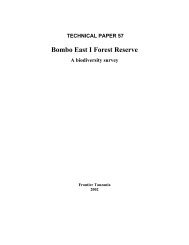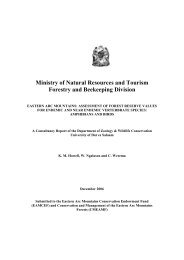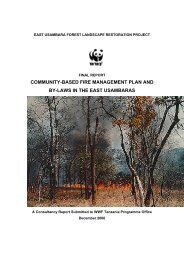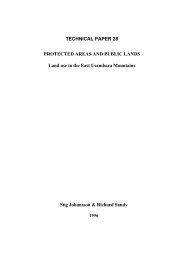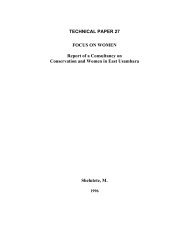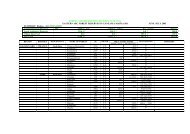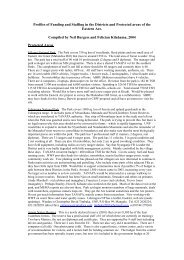Butterfly Farming in the East Usambara Mountains - Eastern Arc ...
Butterfly Farming in the East Usambara Mountains - Eastern Arc ...
Butterfly Farming in the East Usambara Mountains - Eastern Arc ...
Create successful ePaper yourself
Turn your PDF publications into a flip-book with our unique Google optimized e-Paper software.
educe shock, but <strong>the</strong>n generally it is preferable to place <strong>the</strong>m <strong>in</strong> an area where will get<br />
some sun.<br />
• Germ<strong>in</strong>at<strong>in</strong>g Seeds- The technique that has proved most successful for a wide range of<br />
seeds is to prepare a seedbed. The seedbed should consist of <strong>the</strong> soil mix described<br />
previously made <strong>in</strong>to a slightly raised bed under clear plastic or some o<strong>the</strong>r protection<br />
from hard ra<strong>in</strong>. Seeds should be cleaned of as much fruit as possible. The easiest<br />
technique is to peel off <strong>the</strong> sk<strong>in</strong>s and <strong>the</strong>n mix <strong>the</strong> seeds with sandy mud and to scour<br />
<strong>the</strong>m a little by work<strong>in</strong>g this mix between hands. Then, r<strong>in</strong>se <strong>the</strong> seeds clean with water.<br />
The project has found that seeds of all species should not be planted but ra<strong>the</strong>r pressed<br />
slightly <strong>in</strong>to <strong>the</strong> seedbed and <strong>the</strong>n ei<strong>the</strong>r covered with a very th<strong>in</strong> layer of forest soil or<br />
forest leaf litter. F<strong>in</strong>ally, <strong>the</strong> seedbed should be watered regularly, but creat<strong>in</strong>g mud<br />
should be avoided.<br />
• Fertilizer- The best fertilizer is fully composted cow manure. Add<strong>in</strong>g a half-<strong>in</strong>ch layer of<br />
fertilizer to <strong>the</strong> tops of plastic tubes on a monthly basis or as needed for smaller seedl<strong>in</strong>gs<br />
can greatly <strong>in</strong>crease <strong>the</strong> growth rate of host plants.<br />
• Water<strong>in</strong>g- Water<strong>in</strong>g is crucial dur<strong>in</strong>g dry wea<strong>the</strong>r, but can easily be overdone. It is<br />
important to check <strong>the</strong> soil by stick<strong>in</strong>g a f<strong>in</strong>ger an <strong>in</strong>ch or so <strong>in</strong>to <strong>the</strong> soil. If <strong>the</strong> soil is<br />
damp at <strong>the</strong> bottom of <strong>the</strong> <strong>in</strong>ch, water<strong>in</strong>g is probably not necessary. Roll<strong>in</strong>g <strong>the</strong> ends of<br />
plastic tubes makes water<strong>in</strong>g easier. Also it is important to be careful of small seedl<strong>in</strong>gs<br />
when water<strong>in</strong>g as <strong>the</strong>y can be buried or knocked over.<br />
2.2 Quantities Required<br />
• V<strong>in</strong>es – V<strong>in</strong>es tend to regenerate and grow much faster than seedl<strong>in</strong>gs. A v<strong>in</strong>e of a couple<br />
of feet <strong>in</strong> length with plenty of green growth can support one larva every two months<br />
• Herbs – Herbs like Justicia can often be found <strong>in</strong> great numbers. Transplant<strong>in</strong>g is so easy<br />
that it is not necessary to plant large amounts of herbs <strong>in</strong> advance of farm<strong>in</strong>g many<br />
larvae. Though herbs tend to recover quickly, it is often easier to simple plant more than<br />
to wait for eaten plants to recover.<br />
• Seedl<strong>in</strong>gs – The majority of host plants that are needed to farm butterflies <strong>in</strong> Amani are<br />
seedl<strong>in</strong>gs of small and large trees. The food requirements can be very large s<strong>in</strong>ce most<br />
seedl<strong>in</strong>gs require three months to fully recover from be<strong>in</strong>g eaten by larvae. As long as <strong>the</strong><br />
seedl<strong>in</strong>gs has substantial green growth, one seedl<strong>in</strong>g of 1.5 – 2 feet is enough to feed one<br />
larva of species like Papilio ophidicephalus, or two larvae for smaller species like Papilio<br />
echerioides.<br />
To understand what <strong>the</strong>se numbers mean <strong>in</strong> terms of <strong>the</strong> average butterfly-farm<strong>in</strong>g group <strong>in</strong><br />
Amani, it is necessary to make some rough calculations. For <strong>in</strong>stance, <strong>in</strong> 2004, <strong>the</strong> average<br />
butterfly-farm<strong>in</strong>g group can expect to sell about 2250 pupae. This consists of about 1700 pupae<br />
for <strong>the</strong> live exhibit market and about 550 pupae for <strong>the</strong> dead stock market. The live exhibit<br />
market is concentrated <strong>in</strong> 8 months from <strong>the</strong> beg<strong>in</strong>n<strong>in</strong>g of March until <strong>the</strong> end of October. The<br />
15



